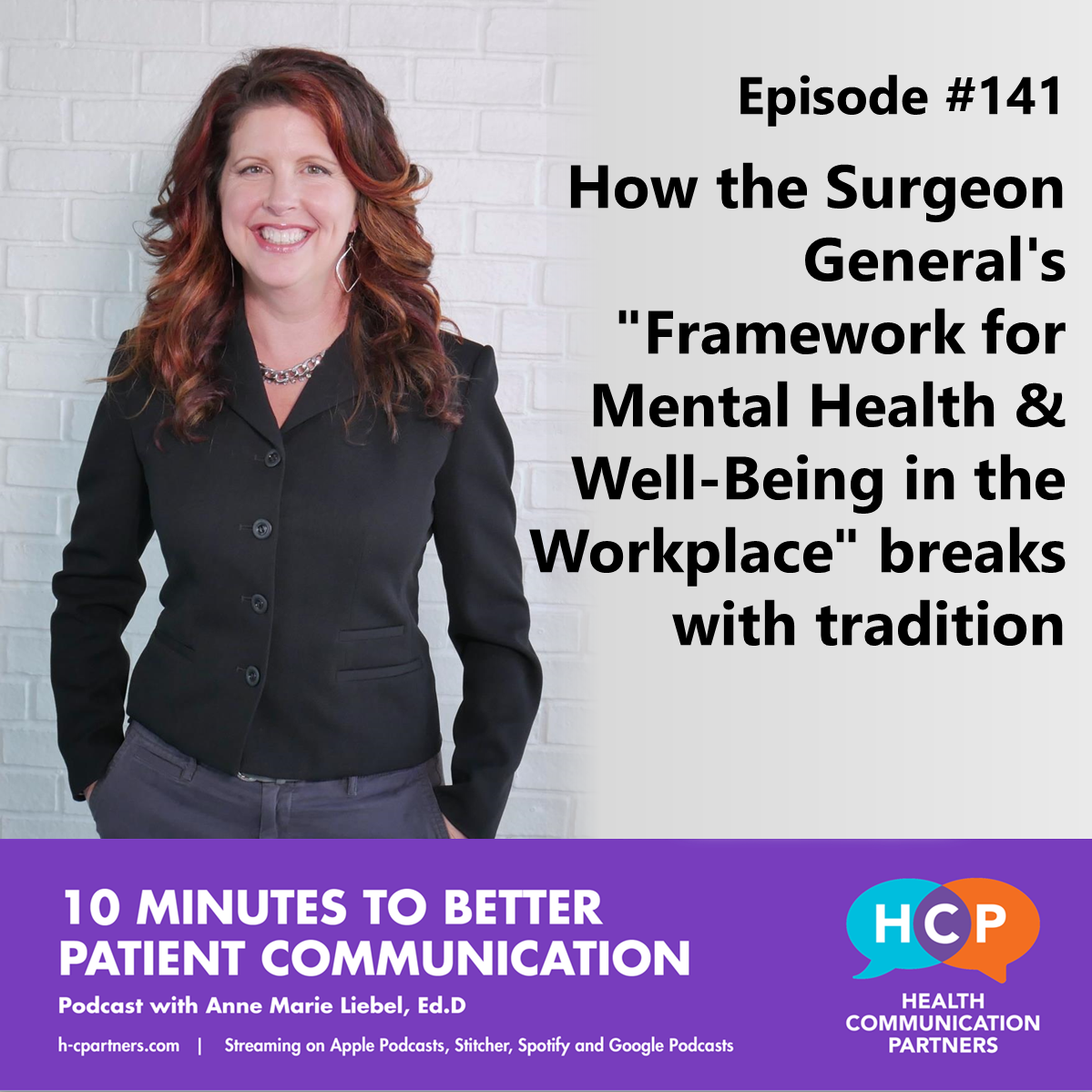I take a close look at The Surgeon General’s Framework for Mental Health & Well-Being in the Workplace and see that it’s not what we’re used to…and that’s a good thing.

EPISODE TRANSCRIPT
In October of 2022, the U.S. Surgeon General, Dr. Vivek Murthy, released Framework for Mental Health & Well-Being in the Workplace. In a post on the HealthCommunicationPartners website, I promised I’d spend more time on this Framework and tell you about it in a future episode. So today, I’ll tell you how this Framework breaks with tradition, in a good way, and why that’s reason to be hopeful.
Hi everybody, I’m Dr. Anne Marie Liebel and this is “10 Minutes to Better Patient Communication” from Health Communication Partners. If your organization cares about equitable communication with all patients, there are some foundational concepts it’s important to understand. That’s why I wrote Foundations of Equitable Interpersonal Communication in Health. It gets at the fundamentals everyone needs to know, and it’s for all patient-facing employees. Learn more at healthcommunicationpartners.com.
The Surgeon General’s Framework for Mental Health & Well-Being in the Workplace came out in October of 2022. Forbes called “CEO required reading.” The Washington Post headline reads, “Bosses should fix toxic workplaces, Surgeon General says.”
Now there are Five Essential elements that make up the heart of the Framework. Here they are: Protection from Harm; Connection and Community; Work-Life Harmony; Mattering at Work; and Opportunities for Growth.
HR people are taking notice, and the ones that have been advocating for change like this have a research-based document to point to, out of a very high profile Federal Agency.
Workplace wellness initiatives are not news to anyone listening here. Physician burnout was labelled a public health crises before the pandemic. In October of 2022, The National Academies released its own National Plan for Health Workforce Well-Being.
In an interview with Bloomberg news, the Surgeon General spoke about making progress on mental health in particular, and that it is down to not just individual words and actions, but structural forces. And that thinking is evident throughout the Framework.
Here’s why this is important. The Framework bucks the trend, or breaks with the tradition, in a good way–the tradition of focusing on individual employee level behaviors.
Instead, this Framework focuses on structural-level change.
For nearly a decade, I’ve heard stories from medical and public health practitioners and students about their individual workplace or school’s wellness activities. No one disputes the need for the attention to employee wellness in medicine and public health. but I’ve heard some dissatisfaction with the ways in which individual organizations have gone about it. One of the critiques centers around approaches that favor individual-level rather than systems-level actions. One med student put it memorably. He said: “They’re making us go to an ice cream social on the lawn, while the building behind us is on fire.”
So I was hopeful when I read the Surgeon General’s Framework, and noticed its explicit systems-level orientation. For example, in the opening pages of the framework we’re given a controlling metaphor, “organizations can function as engines for mental health and well-being.”
There’s terminology that points to structural issues. For example, one component of “Protection from Harm” states: “Organizations can further normalize and support mental health by modeling, communicating, and regularly promoting services.” Another states: “Employers can prioritize diversity, equity, inclusion, and accessibility (DEIA) norms by putting relevant policies and programs in place.” So we’ve got terms like services, policies, normalizing, these point to systems-level actions, good to see.
Communication–which you know I care about–communication itself is addressed several times. “Having clear and consistent communication,” communication’s role in “building trust,” establishing “policies to limit [digital] communication outside of work hours.” And this, which leaped out to me as a pretty nice phrase and kind of a consolidating idea: “The future of work includes both remote and hybrid work, in a variety of full-time and part-time arrangements, so there is even more need to be intentional about how to build teams, communicate, and collaborate.”
Clearly these are not only individual level solutions we’re being given. After reading this it’s kinda laughable to imagine someone suggesting that if only individuals would engage in better behaviors, just buckle down at work, your workplaces wouldn’t be toxic or hazardous to your mental health!
Yet for as much as we know about the importance of looking at systems-level injustices and structural approaches to change; as much research as there is on the need for systemic, institutional and organizational action; as much as all of this is in the public eye, it can be astounding how much individual-level actions still dominate the discourse about health and wellbeing and healthcare.
It’s easy to see why individual level approaches are popular. I mean really, we each of us, I know I could be doing better, than we all are. And how great would it be if we all did eat healthier, move our bodies more regularly, not be addicted to anything!
But overall, the focus on individual-level actions steers attention away from things like root causes, upstream factors, broader approaches to health.
Which is why i think the fact that this Framework is coming from the U.S. Surgeon General, and not from another federal agency, is significant.
Because the U.S. Surgeon General is a person, right?! He’s a medical professional who is very well aware of these dominant discourses. And he chose to break with this individual model that he, the person, Dr. Vivek Murthy, knows very well. You know well because you’re listening to this show. It’s still the dominant approach of individualizing and medicalizing understandings of health, in ways that support or invite individual level solutions. Solutions that almost all the time are behavioral, or pharmacological, or technological or biotechnological. Meanwhile keeping out of view systems-level problems and solutions.
The Framework also stays away from ‘healithism’ and other kinds of ‘lifestyle drift’ approaches to health and mental health that are also well known to many of you in medicine and public health. This overwhelming behaviorist view that individual behaviors are the key to better health. The implication or the outright statement that public health professionals’ job is to motivate or inspire people to voluntarily adopt easy lifestyle changes to promote their health. As if good information and encouragement is all individuals need to be healthier!
This, despite extensive empirical evidence that behavior change accounts for up to only 10-15% of health outcomes. I have Dr. Dennis Raphael at York University to thank for this research, so I’ll put links in show notes.
Health literacy is also working to let go of its individual focus on behaviors and capacities. The most high profile example of this recently is the CDC’s organizational definition of health literacy.
Part of what I find encouraging about the Surgeon General’s model is that it’s an alternative to the common or dominant story in the field that we’ve all heard. The dominant stories we’ve all inherited. This series invites questioning of these dominant narratives, and supports you the people who are already doing it, specifically with tools grounded in equity and justice.
Wherever you work, I encourage you to check out the Surgeon General’s Framework. If you’re in healthcare, let your leadership know about Foundations of Equitable Interpersonal Communication in Health. If you’re not in healthcare, hey, stay tuned: I’ve got something coming for you.

